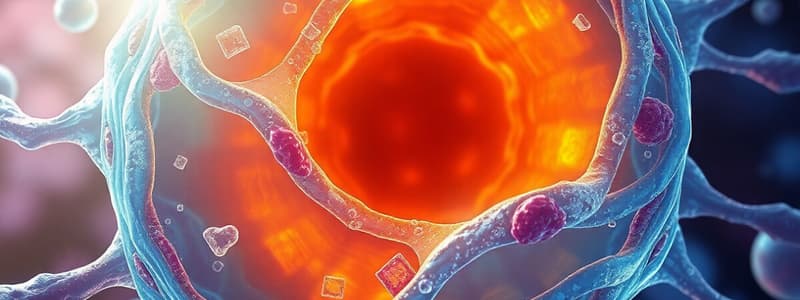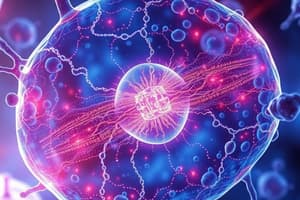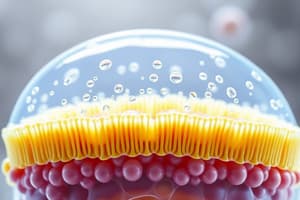Podcast
Questions and Answers
What is the basic unit of life?
What is the basic unit of life?
- Organ
- Organism
- Cell (correct)
- Tissue
The watery medium that surrounds cells is called the:
The watery medium that surrounds cells is called the:
- Cytosol
- Nucleus
- Extracellular fluid (correct)
- Cytoplasm
Which of the following is NOT a function of the plasma membrane?
Which of the following is NOT a function of the plasma membrane?
- Movement of vesicles (correct)
- Structural support
- Physical isolation
- Regulation of exchange with the environment
What type of cellular structure is responsible for muscle contraction?
What type of cellular structure is responsible for muscle contraction?
Ribosomes are found attached to which of the following organelles?
Ribosomes are found attached to which of the following organelles?
The rough endoplasmic reticulum is responsible for:
The rough endoplasmic reticulum is responsible for:
Which organelle is responsible for energy production?
Which organelle is responsible for energy production?
The Krebs cycle occurs in which part of the cell?
The Krebs cycle occurs in which part of the cell?
Which of the following is a function of lysosomes?
Which of the following is a function of lysosomes?
Which cell process does NOT require ATP?
Which cell process does NOT require ATP?
What is the main function of the cytoskeleton?
What is the main function of the cytoskeleton?
Which type of cell junction allows for communication between cells?
Which type of cell junction allows for communication between cells?
The tissue type that lines body surfaces and cavities is called:
The tissue type that lines body surfaces and cavities is called:
What type of epithelium is found in areas where diffusion and filtration occur?
What type of epithelium is found in areas where diffusion and filtration occur?
Which epithelial tissue is specialized for absorption in the small intestine?
Which epithelial tissue is specialized for absorption in the small intestine?
The primary function of connective tissue is:
The primary function of connective tissue is:
What type of connective tissue stores energy and provides insulation?
What type of connective tissue stores energy and provides insulation?
Which of the following is NOT a characteristic of cartilage?
Which of the following is NOT a characteristic of cartilage?
Which muscle tissue is involuntary and found in the walls of hollow organs?
Which muscle tissue is involuntary and found in the walls of hollow organs?
The tissue responsible for transmitting electrical impulses is:
The tissue responsible for transmitting electrical impulses is:
The layer of skin that provides protection against UV radiation is the:
The layer of skin that provides protection against UV radiation is the:
What type of gland produces sweat?
What type of gland produces sweat?
Which of the following is the deepest layer of the epidermis?
Which of the following is the deepest layer of the epidermis?
The dermis is primarily composed of which type of tissue?
The dermis is primarily composed of which type of tissue?
Hair is primarily composed of:
Hair is primarily composed of:
The primary function of the skeletal system is:
The primary function of the skeletal system is:
The long shaft of a bone is called the:
The long shaft of a bone is called the:
Which type of bone cell is responsible for bone formation?
Which type of bone cell is responsible for bone formation?
What is the primary function of yellow bone marrow?
What is the primary function of yellow bone marrow?
Which bones are considered part of the axial skeleton?
Which bones are considered part of the axial skeleton?
What is the process of bone tissue formation called?
What is the process of bone tissue formation called?
The bones of the cranium are classified as:
The bones of the cranium are classified as:
The patella is an example of which type of bone?
The patella is an example of which type of bone?
The bones that make up the wrist are called:
The bones that make up the wrist are called:
The structure responsible for the production of red blood cells is the:
The structure responsible for the production of red blood cells is the:
The most common type of joint in the body is the:
The most common type of joint in the body is the:
Flashcards are hidden until you start studying
Study Notes
Basic Concepts in Cell Biology
- The fundamental unit of life is the cell.
- Cells are surrounded by a watery medium called extracellular fluid.
- The plasma membrane provides structural support, regulates exchanges, and isolates the cell from the environment.
Cellular Structures and Functions
- Microfilaments are responsible for muscle contraction.
- Ribosomes are primarily found attached to the endoplasmic reticulum, particularly in the rough ER where protein synthesis occurs.
- Mitochondria are the organelles responsible for energy production.
- The Krebs cycle takes place in the mitochondrial matrix.
- Lysosomes break down waste materials and damaged organelles.
Cellular Processes
- Simple diffusion does not require ATP, while active transport, endocytosis, and exocytosis do.
- The cytoskeleton provides structural support and shape to the cell.
- Gap junctions enable communication between cells.
Tissue Types and Functions
- Epithelial tissue lines body surfaces and cavities.
- Simple squamous epithelium is specialized for diffusion and filtration.
- Simple columnar epithelium is adapted for absorption, particularly in the small intestine.
- The main function of connective tissue is protection and support.
Connective Tissue
- Adipose tissue stores energy and provides insulation.
- Cartilage is avascular and contains chondrocytes but does not regenerate quickly.
- The nervous tissue transmits electrical impulses.
Skin and Glandular Structures
- The epidermis protects against UV radiation.
- Eccrine glands produce sweat, while the stratum basale is the deepest layer of the epidermis.
- The dermis contains dense irregular connective tissue.
Bone Structure and Function
- The primary functions of the skeletal system are movement and support.
- The long shaft of a bone is known as the diaphysis.
- Osteoblasts are responsible for bone formation; yellow bone marrow primarily functions for fat storage.
- The axial skeleton includes the skull, vertebrae, and ribs.
Bone Types and Joint Characteristics
- Ossification is the process of forming bone tissue.
- Bones of the cranium are classified as flat bones; the patella is a sesamoid bone.
- The bones of the wrist are referred to as carpals.
- The red bone marrow in bones produces red blood cells.
- The most common joint type in the body is the synovial joint.
Joint Classifications
- The joint between skull bones is categorized as a suture, which is a type of fibrous joint.
Studying That Suits You
Use AI to generate personalized quizzes and flashcards to suit your learning preferences.




